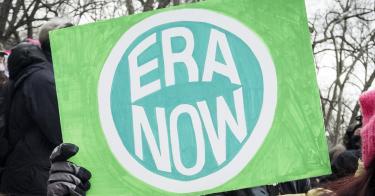On April 30, 2019, the House Judiciary Subcommittee on the Constitution, Civil Rights, and Civil Liberties held a hearing titled “The Equal Rights Amendment.” Rep. Carolyn Maloney (D-NY), the ERA’s lead House sponsor for two decades, flatly insisted that it “has absolutely nothing to do with abortion.”
Some might have been tempted to quote Queen Gertrude from Shakespeare’s Hamlet that “the lady doth protest too much, methinks.” In a recent decision, the Pennsylvania Supreme Court has shown why no one believed her anyway.
Congress proposed the ERA, first introduced in 1923, in March 1972. It read: “Equality of rights under the law shall not be denied or abridged by the United States of by any State on account of sex.” Fewer than the necessary three-fourths of the states, however, ratified it by the deadline Congress imposed.
The 1972 ERA failed for two reasons. First, the ERA’s twin objectives had already been met without it. States and the federal government had been eliminating discriminatory laws since the 1930s. And the Supreme Court had interpreted the Fourteenth Amendment’s requirement of equal protection to apply to sex discrimination.
>>> The ERA Has Just One Purpose Left: Abortion
Second, even after decades and dozens of hearings, no consensus existed, even among supporters, about what the ERA’s indeterminate language meant or how it would apply. Untethered to its original purpose, the ERA was thus ripe for use to achieve other political goals such as abortion rights.
Abortion activists had for years made clear their intention to use the ERA to that end. The 1977 National Women’s Conference Action Plan, for example, called for both ratification of the ERA and protection of “reproductive freedom.” At its January 1979 meeting, President Jimmy Carter’s National Advisory Committee for Women explicitly connected the ERA to its pro-abortion agenda.
A year later, the same committee explained that examining the application of similar ERAs in state constitutions would be an “easy way” to understand the federal ERA’s impact. The Pennsylvania Supreme Court’s recent decision in Allegheny Reproductive Health Center v. Pennsylvania Dept. of Human Services is Exhibit A.
In this case, abortion clinics challenged a state law prohibiting spending public funds for the performance of abortion except to save the mother’s life or when the pregnancy resulted from rape or incest. They argued that three provisions guarantee the general equal protection of the laws and the state ERA specifically prohibits discrimination “because of the sex of the individual.” One of the court’s seven members did not participate and the court voted 4-2 to overrule its unanimous 1985 decision in Fischer v. Dept. of Public Welfare, which held in a similar challenge that the funding exclusion did not violate these same constitutional provisions.
The majority paid lip service to the principle that the basis for interpreting a constitutional provision must be its “plain language” and that there must be a “special justification” to overrule a precedent “over and above the belief that [it] was wrongly decided.” The majority, however, did not actually use these principles to reach its conclusion. The heart of Fischer was that the requirement for state funding of abortion when it funded the exercise of other constitutional rights was “found no where in our state Constitution.” That conclusion focused squarely where it should, on the constitutional text.
>>> Federal Appeals Court Foils Another Biden Abortion Scheme
The basic equal protection principle is that the law should treat similarly situated people similarly. Men and women are obviously not similarly situated with respect to either pregnancy or abortion. Despite the new claims of some gender activists, men cannot get pregnant. A law prohibiting abortion does not, therefore, treat men and women differently or, put in the Pennsylvania ERA’s terms, discriminate against women on account of their sex.
No matter. The court obviously wanted to reach a particular result, and neither the text of the Pennsylvania Constitution nor its own previous interpretation of that text would stand in the way.
Chief Justice Debra Todd dissented, not only arguing that no justification existed for overruling Fischer but observing that, in reality, the case did not properly involve the right to abortion at all. The differential treatment, if any existed, was between two classes of women – those giving birth and those seeking abortion – rather than between men and women.
The U.S. Supreme Court overruled Roe v. Wade in June 2022, holding what anyone reading the Constitution would know, that it “does not confer a right to abortion.” No wonder abortion activists are again pushing for ratification of the ERA while trying in vain to cover their tracks.
This Pennsylvania decision shows not only that abortion advocates will use any means at their disposal to promote it, but that they would do the same for the country if the ERA ever became part of the U.S. Constitution.
This piece originally appeared in Christian Renewal




